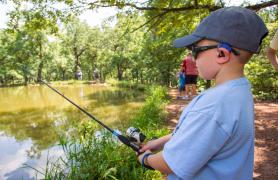All it took was one dark night and a food-filled freezer on an outside porch to convince Ginny Dubach that bears don’t always rely on nature for nourishment.
“He got fried chicken and he got frozen food, too. He wasn’t particular,” said Dubach of a 2017 incident in which a bear raided a freezer at the side of their cabin near Oldfield in rural Christian County. Ginny’s husband, Merrill, said that a package of frozen elk meat was also pilfered by “Clyde.”
The Charm and the Challenge
Yes, the Dubachs had a name for the animal that filched their frozens. Up until Clyde’s food search led him from field and stream to freezer, he hadn’t ventured near the Dubachs’ cabin, but had been seen occasionally in the surrounding area. As the Dubachs discovered, bear sightings in 21st-century Missouri present both charm and challenge. It’s all part of living in bear country and being bear aware.
“For many Missourians, they have not had to think about living in ‘bear country,’ but the fact is, ‘bear country’ is expanding in our state, and many folks are already living with bears in their counties or have the possibility of having bears living within their counties in the future,” said Laura Conlee, an animal resource scientist for MDC and the state’s bear biologist.
A Growing Population
At present, Missouri’s black bear population is estimated to be between 300–350, most of which are located in the southern part of the state. When the first settlers came to Missouri, the black bear (the only type of bear found in Missouri) ranged across most of the state. As Missouri became settled, the state’s black bear population dwindled. Bears were shot for their meat, for their fur, for the alarm they caused (whether they were harming anything or not), and for the market in bear grease that existed in the U.S. in the early 1800s. By the end of the 19th century, unregulated hunting and habitat destruction had reduced Missouri’s bear population to a small number foundonly in remote parts of the state. By the mid-1900s, it was thought the only place bears could be seen in Missouri was on the state seal.
But the black bear’s story in Missouri wasn’t finished. From 1958 to the late 1960s, the Arkansas Game and Fish Commission trapped more than 200 bears in Minnesota and Manitoba, Canada. They relocated them to Arkansas to bolster the small population still thought to be roaming the state. This population took hold, and wandering bears from Arkansas soon began appearing in Missouri. It is thought most of the bears seen in Missouri today are the result of Arkansas’ reintroduction program, although genetic evidence collected in bear studies in Missouri suggest that a small, remnant population may have held on in this state.
Tracking Their Presence
Regardless of what their heritage is, there is no doubt that black bears are part of Missouri’s outdoor landscape today. Currently, MDC biologists are putting GPS collars on female bears so they can study reproductive success, litter sex ratios, and cub survival during winter denning. GPS collars are also used to monitor home ranges, habitat use, and the impacts of habitat on how the population expands within the state.
Along with this scientific data, there’s also plenty of citizenscience information about Missouri’s bear population. From 2011 to 2017, MDC received 1,341 bear reports in 87 counties. While these numbers may contain a few misidentifications, biologists feel these reports give further credence to what their research is indicating — that Missouri’s bear numbers are growing and the animal’s range in the state is expanding.
“At present, bears are most commonly found in forested areas of southern Missouri. In many of our southern counties, bears have been there for a number of years,” Conlee said. “But our bear population is expanding and pushing into areas with higher human population densities, where many folks have had little experience with bears.” Missouri bears have been seen in some unlikely places:
- In 2012, a bear climbed a tree in the middle of the Webster County community of Seymour and remained in the tree all day before climbing down after dark and exiting the community.
- In 2017, a bear was photographed walking through a neighborhood of Republic in Greene County after dark.
- In 2018, footage was taken of a bear walking through a residential area of Ballwin, a St. Louis suburb in St. Louis County.
Expect Visitors, but Don’t Feed Them
What these types of sightings mean is that a growing number of Missourians face the prospect of either receiving random visits or sharing their living spaces with a large mammal that weighs several hundred pounds, has a large amount of strength and curiosity, and is on a never-ending quest for food.
“A bear’s life literally revolves around food, no matter their size or their sex” said MDC Wildlife Damage Biologist Josh Wisdom. “In the spring, it’s about eating to get back into shape because they are recovering from denning. Then, for a month or so in the summer, eating provides strength for breeding. After that, it’s all about trying to gain weight to go back to sleep in the winter.”
It’s this ongoing search for sustenance that sometimes lead bears into the ’burbs.
“In a natural setting, a bear would travel miles over land and eat nuts, berries, and so on as it finds them,” Wisdom said. “In an urban setting, a bear might only have a 3-mile loop where it still eats the normal wild foods, but also visits dumpsters, bird feeders, and the like repeatedly. Not only does this condition the bear to keep eating human-supplied foods, but it makes the bear very visible to residents and, along with that, usually creates a little hysteria, as bears are still new to most residents of Missouri.”
No Cause for Alarm
This anxiety about bears — which has been fueled by decades of negative publicity from Hollywood — is a fear that is somewhat misguided when it comes to black bears. Wisdom emphasizes that seeing a bear in the woods or one that’s merely crossing property usually isn’t a cause for alarm.
“For the most part, people should not worry about seeing a bear at all,” he said. “Bears are a valuable native species and attacks are extremely rare.
“For example,” he continued, “if you see a bear while out hiking or hunting in the woods, consider yourself lucky and enjoy the experience. Make sure the bear sees you, make sure cubs aren’t around if it’s in the spring or summer, and give the bear plenty of room. Seeing a bear cross a road or out in a pasture is also not cause for alarm, even if cattle are present.”
When a bear gets near buildings or homes, the threat to human safety is still low, but concerns for property damage increase. A raided chicken coop, a ripped-up shed, or a destroyed beehive may not cause bodily injury to property owners, but property damage can put pain on their pocketbooks. However, even in a situation that involves property damage, nonlethal harassment techniques coupled with a little preventive maintenance often will cause a bothersome bear to move on.
In the Dubachs’ case, Wisdom provided the family with pyrotechnics designed for wildlife dispersal to get rid of Clyde. It was a type of scare cartridge, a nonlethal exploding device that’s designed to frighten nuisance wildlife.
“I shot him right in the rear,” Merrill said. “It bounced off him and exploded, just like it was supposed to. I haven’t seen him since.” The Dubachs also bear-proofed their new on-theporch freezer by encasing it in a wooden box and putting a strong latch secured with a cotter pin on the door.
“We are being pretty careful,” Merrill said. “I’m sure there are enough bears around that another situation could get started pretty quick.”
Vigilance is important, Conlee said, particularly in areas where bears have either been seen or reported.
“The fact is, bears are part of our natural environment and they will remain part of the Missouri landscape,” she said. “It’s MDC’s responsibility to help educate the public on preventing conflicts with bears, but people that live in bear country may also need to adapt to ensure they aren’t providing food for bears and are doing their best to keep them wild.”
To put it simply, Conlee said, people need to be bear aware.
“Being bear aware is a proactive approach to preventing and/ or reducing human-bear conflicts,” she said. It means that you have a general understanding of how to live and be outdoors in bear country. Know what foods attract bears and how you can ensure they don’t have access to human-associated foods. Understand what to do if you encounter a bear in your yard or while in the woods. Help educate family, friends, and neighbors about living in bear country.”
For the Dubachs, being bear aware is about coexistence. “It (bear issues) is part of living out here,” Merrill said. “They live out here, too. I hope Clyde is still running around,” to which Ginny quickly added, “Just not on my porch.” If you see a bear, report it at mdc.mo.gov/ReportBears.
Be Bear Aware on the Trail and at Home
As bears make their comeback in Missouri, take a few minutes to browse the guidelines for hiking, camping, and managing your property in ways that keep you safe and bears from becoming a nuisance. Visit short.mdc.mo.gov/Zky.


























Also In This Issue


And More...
This Issue's Staff
Associate Editor - Larry Archer
Staff Writer - Bonnie Chasteen
Staff Writer - Heather Feeler
Staff Writer - Kristie Hilgedick
Staff Writer - Joe Jerek
Creative Director - Stephanie Thurber
Art Director - Cliff White
Designer - Les Fortenberry
Designer - Marci Porter
Photographer - Noppadol Paothong
Photographer - David Stonner
Circulation - Laura Scheuler






















